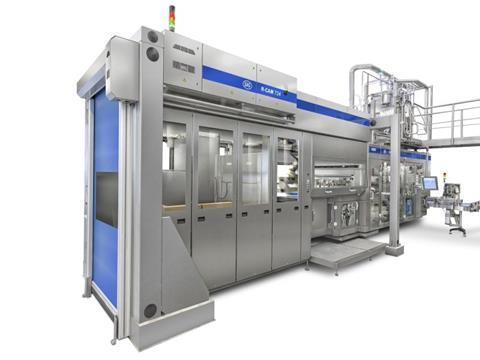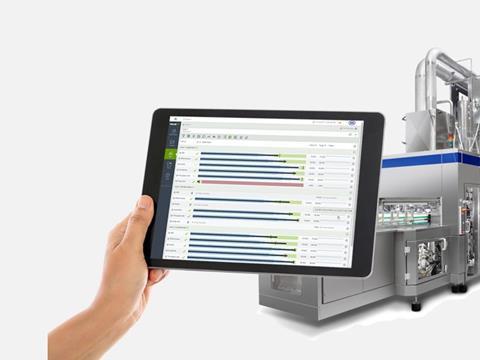
Dr. Daryoush Sangi, SIG’s Head of Production Engineering & Strategic Partnerships, shares his insights for creating a smarter factory and navigating the era of Industry 4.0.
Food and beverage production is rapidly changing and becoming more demanding than ever. As filling plants and factories operate on an unprecedented scale, production lines need to be more flexible, individualised and agile to handle periods of higher outputs and faster product changes. This can only be achieved by securing greater asset optimization – by configuring the optimal long-term infrastructure that can flexibly handle any operational demand and by ensuring intelligent recipe, production planning and job handling throughout production.
What, in your opinion, are the biggest challenges for food and beverage manufacturers today?
Dr. Daryoush Sangi: The future of food and beverage production is about satisfying a growing demand for healthy, convenient products that are safe, sustainable, affordable and differentiated. All businesses are under growing pressure to increase output, improve margins and optimise assets. Filling plants need to be smarter and more automated to handle operations intelligently, optimise production, increase efficiency and be more transparent. This means it’s crucial to get the most out of filling units, reduce the risk of downtime and to connect, automate and monitor lines. All while driving down costs.
How can manufacturers approach the topic of a smart factory?
Dr. Daryoush Sangi: A report by The Manufacturer states that while 67% of UK manufacturers see Industry 4.0 as an opportunity, only 25% feel they have sufficient understanding of its implications. That’s why SIG are developing new technology and processes to ensure manufacturers are ready for Industry 4.0. The first step could be to upgrade existing solutions. Managing a factory is a juggling act between product quality, machine availability and performance. To get most out of the individual filling lines, food and beverage producers could consider an integrated solution, which will increase utilisation and reduce total filling costs. A tailored service agreement can also ensure each of these areas gets the attention they need. In this way producers can gain maximum value and performance.
If these possibilities are explored, what would be the next logical step?
Dr. Daryoush Sangi: The next logical step would be to transform automated technology. Optimising one or more of the existing filling lines can unlock their hidden potential. Robotics and artificial intelligence, for example, have the potential to radically transform how we produce. SIG’s Robotic Magazine – called R-CAM – is a good example. It enables manufacturers to create more efficient workflows and to reduce manual work hours. Another step toward building fully-automated filling lines is with automated guided vehicles, which can transport packaging pallets and materials from a central store to the R-CAM. Learning controllers adapt the operational, logistical and individual needs of the producers, and reduce the visible complexity of the factory.
What is behind SIG's Robomatic magazine?

Dr. Daryoush Sangi: The Robotic Magazine offers customers a crucial component on the road to greater automation. The R-CAM for high-speed filling machines that fill up to 24,000 carton packs per hour loads the filling machine with carton sleeves fully automatically – a real gain in terms of the efficiency of workflows and reducing the amount of manual work. Food and beverage manufacturers who operate filling machines from SIG receive the carton sleeves in shipping boxes on pallets. Without using the R-CAM, the shipping boxes have to been removed from the pallet and loaded into the filling machine’s magazine by an employee. With the Robotic Magazine the shipping boxes are removed from the pallet and opened, and the filling machine is loaded with carton sleeves – fully automatically. This process does not require any action from the machine operator. The workflows are more efficient, save working time and costs. Implemented sensors and scanners make sure that the sleeves are matching to the recipe, avoiding production errors.
How does this work?
Dr. Daryoush Sangi: The Robotic Magazine basically consists of two modules: the pallet magazine and the unpacking station. The pallet magazine offers space for a Euro pallet, Industrial pallet or Australian pallet. Once the pallet is inside the magazine, a scanner records the arrangement of the shipping boxes on the pallet. The gripper arm moves a shipping box to the unpacking station. The Robotic Magazine has an internal buffer, which ensures that production can continue to run smoothly even while a new pallet is being loaded into the pallet magazine. This buffer can accommodate up to 20 shipping boxes of carton sleeves. The magazine can operate for up to 2.5 hours without the need to top it up with a new pallet. Inside the unpacking station, the shipping boxes are opened and the sleeves are removed from the box. The sleeves are automatically filled into the appropriate track of the filling machine, and the shipping boxes are folded flat and collected in a specially provided container for subsequent disposal.Internet of Things (IoT) technology, such as sensors, software and connectivity solutions, can help to monitor and to analyse the productivity of a filling line. Using these technologies, SIG engineers for example can conceptualise, design and engineer complete end-to-end plants that are intelligent, automated and fully integrated.The combilLink monitoring system for example offers a new way to track a line and intervene and optimise operations whenever necessary.
What are combiLink's main features?

Dr. Daryoush Sangi: combiLink is a monitoring system that allows for analysing the efficiency and productivity of the complete filling line and offers complete connectivity. It can communicate seamlessly with overarching enterprise software, closing the information gap between the business and production levels. It helps to optimise the complete filling and downstream operations. combiLink provides a full range of insight in the complete line – including the filler, the buffer, the applicator, the shrink wrapper and all other components of the line. With the same connectivity used in Internet of Things applications, combiLink interconnects every machine in the line, giving our customers a single window into current and historical levels of efficiency and performance – and showing where improvements would be beneficial.
combiLink is built using open architecture, making it future-proof. In other words: we’ll continue to add new applications going forward and customers can also create their own customised plug-ins using the software development kit supplied. The system includes powerful analysis and reporting tools that drill down into the data and visualise it graphically to accelerate customer’s decision-making. combiLink’s connectivity is based on the latest industrial communication standards like for example PackML, OMAC or OPC UA. This enables the system to collect information from every machine in the line and store it securely. combiLink can also send data out to other enterprise applications. Its open architecture and standards-based interfaces facilitate connection to other third-party systems too, such as those supporting the supply chain, warehouse and logistics operations.
The customer can visualise the filling line data in a variety of preconfigured reports, or build his own for specific views. Out of the box, customers can view charts showing the OEE, the technical and organisational efficiency levels and an analysis of downtime incidents. He can view these reports on a desktop, tablet or smartphone – even if he’s on the other side of the world. Smart notifications alert the team of any incidents or issues and help avoiding bottlenecks and downtime before they arise. combiLink protects data during transmission between the machines and the server, as well as during storage. It provides a granular user permissions system that lets the customer define exactly who can access which data.
Are there any other innovations you would like to highlight?
Dr. Daryoush Sangi: SIG partners with providers of automation and process control systems like Manufacturing Execution Systems (MES), to co-create innovative manufacturing solutions for food, beverage and dairy producers. Through such partnerships, we will be able to offer producers advanced production technology and integrated software solutions. These alliances will also allow us to combine expertise for the joint development of innovative MES products, offering integrated solutions for smart and automated factories all over the world.

















